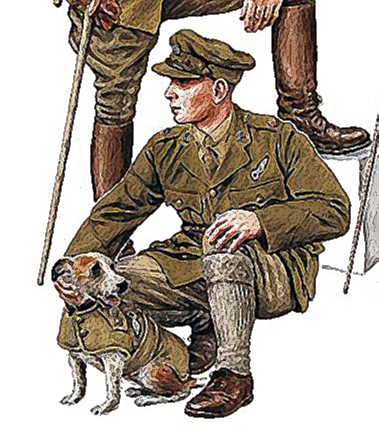


1917 RFC Observer lieutenant tenue Ete Bruxelles
English Translation
 |
The change in role of the pilot from "driver" occured when duplication of the German-developed interruptor gear attached to a captured Fokker, allowing forward firing through the propellor, was applied to British aircraft, allowing the pilot and his aeroplane to become an effective attacking forward gun platform. The Observer role continued and also took on the active role of gunner with a semi-fixed multi-directional gun.
It should be noted that in the very early days of military flying in the Royal Flying Corps, variations in badges was more or less the normal situation, many being hand-made by tailors. There are certain distinguishing features which allow one to discern early issues and those issued to the RAF between 1918 and 1942, when the role of Observer was finally replaced by other more singular designations.
All airmen issued the Observer wing were permitted to continue to wear it, even if no longer longer actively involved with aerial duty. This applied both when the RFC became the RAF in 1918 and also applied to the former RFC observers recalled to duty, aerial or otherwise just before and during the early days of WW2. The same applied to airmen qualified to wear the observer badge after its cessation of issue in 1942.
Badge
Until late 1915 most observers were posted to squadrons direct from their battalions, and learned their new skills at the Front. Even after that there was no dedicated observer school throughout most of 1916, and most observers were posted to squadrons in England that were mobilising for France, and got what training they could in the squadron. It was only in the autumn of 1916 that an observer section was formed at the wireless school at Brooklands with an output of about twenty observers per month.
From around June 1917 it was decreed by the RFC that the Observer's badge was a War Service badge such as a wound stripe or bravery decoration, and not a trade or service badge such a pilot's wings or a marksmanship badge. This meant that observer's had to EARN the right to wear the badge they had qualified for on a course by actually serving six weeks with a squadron AND then, in addition, getting their C.O.'s recommendation. Until that time they were classified as 'probationary' observers. This applied to any officer or N.C.O. who had passed the observer's course and was posted to the squadron as a probationary observer. I haven't found any reference to the number of hours flown, although it might have been an unofficial requirement from Squadron commanders.
Historique Voir ICI
History Click HERE
Voir aussi See also
1917 Royal Flying Corps Pattern Short RFC Flying Jacket
1917 Royal Flying Corps Aviateur Londres
1917 Royal Flying Corps Major Mac Cudden Londres IWM
1915 Royal Flying Corps Aviateur Pattern Sidcot Flying
1918 Royal Flying Corps Aviateur Captain La Ferté Alais